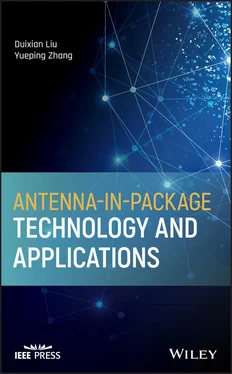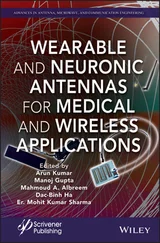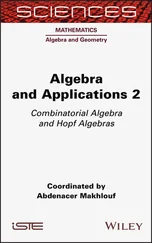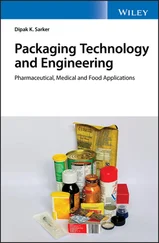Duixian Liu - Antenna-in-Package Technology and Applications
Здесь есть возможность читать онлайн «Duixian Liu - Antenna-in-Package Technology and Applications» — ознакомительный отрывок электронной книги совершенно бесплатно, а после прочтения отрывка купить полную версию. В некоторых случаях можно слушать аудио, скачать через торрент в формате fb2 и присутствует краткое содержание. Жанр: unrecognised, на английском языке. Описание произведения, (предисловие) а так же отзывы посетителей доступны на портале библиотеки ЛибКат.
- Название:Antenna-in-Package Technology and Applications
- Автор:
- Жанр:
- Год:неизвестен
- ISBN:нет данных
- Рейтинг книги:3 / 5. Голосов: 1
-
Избранное:Добавить в избранное
- Отзывы:
-
Ваша оценка:
- 60
- 1
- 2
- 3
- 4
- 5
Antenna-in-Package Technology and Applications: краткое содержание, описание и аннотация
Предлагаем к чтению аннотацию, описание, краткое содержание или предисловие (зависит от того, что написал сам автор книги «Antenna-in-Package Technology and Applications»). Если вы не нашли необходимую информацию о книге — напишите в комментариях, мы постараемся отыскать её.
Written for students in electrical engineering, professors, researchers, and RF engineers,
offers a guide to material selection for antennas and packages, antenna design with manufacturing processes and packaging constraints, antenna integration, and packaging.
Antenna-in-Package Technology and Applications — читать онлайн ознакомительный отрывок
Ниже представлен текст книги, разбитый по страницам. Система сохранения места последней прочитанной страницы, позволяет с удобством читать онлайн бесплатно книгу «Antenna-in-Package Technology and Applications», без необходимости каждый раз заново искать на чём Вы остановились. Поставьте закладку, и сможете в любой момент перейти на страницу, на которой закончили чтение.
Интервал:
Закладка:
AiP technology balances performance, size, and cost, hence it has been widely adopted by chipmakers for 60‐GHz radios, augmented/virtual reality gadgets, and gesture radars. It has also found applications in 79‐GHz automotive radars, 94‐GHz phased arrays for imaging and data communications, 122‐GHz, 145‐GHz, and 160‐GHz sensors, as well as 300‐GHz wireless links. Recently, AiP technology has been under further development for millimeter‐wave (mmWave) fifth‐generation (5G) technology. Scalable large AiPs and multiple small AiPs have been successfully demonstrated in base stations, mobile phones, and networked cars at 28 GHz. We therefore believe that AiP technology will cause fundamental changes in the design of antennas for mobile communications for 5G and beyond operating in mmWave bands.
The development of mmWave AiP technology is particularly challenging because of the associated complexity in design, fabrication, integration, and testing. This book aims to face these challenges through disseminating relevant knowledge, addressing practical engineering issues, meeting immediate demands for existing systems, and providing the antenna and packaging solutions for the latest and emerging applications.
This book contains 11 chapters. The first five chapters lay some foundation and introduce fundamental knowledge. After the introductory chapter about how AiP technology has been developed as we know it today, several types of antennas are discussed in Chapter 2. An attempt is made to summarize the basic antennas and those antennas specifically developed for AiP technology. Emphasis is given to microstrip patch antennas and arrays, grid array antennas, Yagi–Uda antennas, and magneto‐electric dipole antennas because of their dominance in AiP technology. Performance improvement techniques of antennas for AiP technology are also described. Chapter 3describes today's mainstream packaging solutions with either wire‐bond or flip‐chip interconnects, wafer‐level package, and fan‐out wafer‐level package. Chapter 4focuses on the electrical, mechanical, and thermal co‐design for AiP modules. More importantly, the thermal management considerations for next‐generation heterogeneous integrated systems are reviewed in order to address the growing need for cooling the high‐power devices of future radio systems. Chapter 5presents the design and optimization of an anechoic test facility for testing mmWave integrated antennas. This facility can be used for both probe‐based and connector‐based measurements.
The next five chapters are related to the design, fabrication, and characterization of AiPs in different materials and processes for mmWave applications. Chapter 6discusses low‐temperature co‐fired ceramic (LTCC)‐based AiP. LTCC has unique properties for packaging mmWave circuits since it can provide a durable hermetic package with antennas, cavities, and integrated passive components. Chapter 7illustrates how industrial organic packaging substrate technology used for classical integrated circuit (IC) packaging can support the development of innovative, efficient, and cost‐effective mmWave AiPs from 60 GHz up to 300 GHz. Chapter 8focuses on embedded wafer‐level ball grid array (eWLB)‐based AiP. Unlike LTCC or high‐density integr (HDI), eWLB eliminates the need for a laminate substrate and replaces it with copper redistribution layers. Polymers are used for the electrical isolation between the metal layers. The metal routings are deposited by a combination of sputtering and electroplating with a thin film process. eWLB has historically been developed for mmWave automotive radar systems and therefore has naturally been used for mass production of mmWave AiPs. Chapter 9presents surface laminar circuit (SLC)‐based AiP. Compared to LTCC, HDI, and eWLB, SLC is more suitable for fabrication of very large or dense AiPs. The chapter describes SLC materials and design guidelines, and then addresses the design challenges and solutions for 8 × 8 dual‐polarized phased arrays at 94 GHz for imaging and 28 GHz for 5G base station applications, respectively. Chapter 10introduces different additive manufacturing technologies, methods to characterize three‐dimensional (3D)‐printed materials, a hybrid printing process by integrating 3D and inkjet printing, and a broadband 5G AiP realized with the hybrid process.
The last chapter turns to 3D AiP for power transfer, sensor nodes, and Internet of Things applications. This package has a cubic geometry with radiating antennas on its surrounding faces. The chapter highlights small antenna design and miniaturizing techniques as well as multi‐mode capability as a way to achieve wideband antennas.
This book is the result of the joint efforts of the 21 authors in eight different institutions in Asia, Europe, and the United States. A book on an emerging topic like AiP technology would not have been possible without such collaborations. We thank all authors for their creative contributions and careful preparation of manuscripts. We are also pleased to acknowledge the professional cooperation of the publishers.
Duixian Liu IBM Thomas J. Watson Research Center Yorktown Heights, NY, USA
Yueping Zhang School of Electrical and Electronic Engineering Nanyang Technological University Singapore
Abbreviations
| 2D | two‐dimensional | |
| 3D | three‐dimensional | |
| 3GPP | 3rd Generation Partnership Project | |
| 5G | fifth‐generation | |
| ABS | acrylonitrile butadiene styrene | |
| ACE | Advanced Semiconductor Engineering, Inc. | |
| ACP | aperture‐coupled patch | |
| ADS | Advanced Design System | |
| AIA | active integrated antenna | |
| AiM | antenna in a module | |
| AiP | antenna‐in‐package | |
| AM | additive manufacturing | |
| AMC | artificial magnetic conductor | |
| AoB | antenna on a board | |
| AoC | antenna on a chip | |
| AR | axial ratio | |
| ARM | advanced reduced‐instruction set‐computer machine | |
| ASIC | application‐specific integrated circuit | |
| ASUT | antenna system under test | |
| AUT | antenna under test | |
| Az | azimuth | |
| BCB | benzocyclobutene | |
| BC‐SRR | broadside‐coupled SRR | |
| BER | bit error rate | |
| BERT | BER tester | |
| BiCMOS | bipolar complementary metal oxide semiconductor | |
| BGA | ball grid array | |
| BLE | Bluetooth low energy | |
| BT | Bluetooth | |
| BT | bismaleimide triazine | |
| BW | bandwidth | |
| C4 | controlled collapse chip connection | |
| CATR | compact antenna test range | |
| CCL | copper‐clad laminate | |
| CLIP | continuous liquid interface printing | |
| CMA | characteristic mode analysis | |
| CMF | conjugate match factor | |
| CMG | conjugate match gain | |
| CMOS | complementary metal‐oxide semiconductor | |
| CNC | computer numerical controlled | |
| CP | circular polarization | |
| CPS | coplanar strip | |
| CPU | central processing unit | |
| CPW | coplanar waveguide | |
| CT | computer tomography | |
| CTE | coefficient of thermal expansion | |
| CUF | capillary underfill | |
| DC | direct current | |
| DLP | digital light projection | |
| DMA | dynamic mechanical analysis | |
| DRAM | dynamic random‐access memory | |
| DRIE | deep reactive ion etching | |
| EBG | electromagnetic bandgap | |
| EIRP | equivalent isotropic radiated power | |
| El | elevation | |
| EM | electromagnetic | |
| EMI | electromagnetic interference | |
| ESD | electrostatic discharge | |
| ETS | embedded traces | |
| eWLB | embedded wafer‐level ball grid array | |
| EZL | embedded Z line | |
| FCC | Federal Communications Commission | |
| FDM | fused‐deposition modeling | |
| FE | front end | |
| FF | far‐field | |
| FMCW | frequency modulated continuous wave | |
| FoM | figure of merit | |
| FO PoP | fan‐out package‐on‐package | |
| FO‐WLP | fan‐out wafer‐level packaging | |
| FPGA | field‐programmable gate array | |
| FR4 | flame resistant 4 | |
| FSS | frequency selective surface | |
| GaAs | gallium arsenide | |
| GaN | gallium nitride | |
| Gb/s | gigabit per second | |
| GPU | graphics processing unit | |
| GSG | ground‐signal‐ground | |
| GSGSG | ground‐signal‐ground‐signal‐ground | |
| GSM | global system for mobile communications | |
| HAST | highly accelerated stress test | |
| HBM | high bandwidth memory | |
| HDI | high‐density integration | |
| HDI | high‐density interconnect | |
| HFSS | high‐frequency structure simulator | |
| HPBW | half‐power beam width | |
| HTCC | high‐temperature co‐fired ceramics | |
| IC | integrated circuit | |
| IEEE | Institute of Electrical and Electronics Engineers | |
| IF | intermediate frequency | |
| InFO_PoP | integrated fan out package on package | |
| I/O | input/output | |
| IoT | Internet of Things | |
| ISM | industrial, scientific and medical | |
| ISSCC | International Solid‐State Circuits Conference | |
| JPL | jet propulsion laboratory | |
| LCD | liquid crystal display | |
| LCP | liquid crystal polymer | |
| LGA | land grid array | |
| LHCP | left‐hand circular polarization | |
| LNA | low‐noise amplifier | |
| LP | linearly polarized | |
| LTCC | low‐temperature co‐fired ceramic | |
| MACM | multiple amplitude component method | |
| MAPCM | multiple amplitude phase component method | |
| MCM | multi‐chip module | |
| MEMS | micro‐electromechanical systems | |
| MIM | metal–insulator–metal | |
| MIMO | multiple input multiple output | |
| MMIC | monolithic microwave integrated circuit | |
| MMWAC | mmWave anechoic chamber | |
| mmWave | millimeter‐wave | |
| mSAP | modified semi‐additive process | |
| MUF | molded underfill | |
| NF | near‐field | |
| NF | noise figure | |
| NIST | National Institute of Standards and Technology | |
| NRE | non‐recurring engineering | |
| NRW | Nicholson–Ross–Weir | |
| OTA | over‐the‐air | |
| PAE | power‐added efficiency | |
| PAM | phase amplitude method | |
| PBO | polybenzoxazoles | |
| PCB | printed circuit board | |
| PEC | perfect electric conductor | |
| PER | packet error rate | |
| PET | polyethylene terephthalate | |
| pHEMT | pseudomorphic high electron mobility transistor | |
| PI | polyimide | |
| PLA | polylactic acid | |
| PLL | phase‐locked loop | |
| PMC | perfect magnetic conductor | |
| PP | polypropylene | |
| PPM | polarization pattern method | |
| PTH | plated‐through‐hole | |
| p.u.l. | per unit length | |
| QFN | quad flat non‐leaded | |
| QFP | quad flat package | |
| R&D | research and development | |
| RAM | random‐access memory | |
| RCC | resin‐coated copper | |
| RCS | radar cross‐section | |
| RDL | redistribution layer | |
| RF | radio frequency | |
| RFIC | radio frequency integrated circuit | |
| RFID | radio‐frequency identification | |
| RHCP | right‐hand circular polarization | |
| RLCG | resistance, inductance, capacitance, and conductance | |
| RMS | root mean square | |
| RoHS | Restriction of Hazardous Substances Directive | |
| RSM | rotating source method | |
| RX | receiver | |
| SAM | scanning acoustic microscopy | |
| SAP | semi‐additive process | |
| SAR | synthetic aperture radar | |
| SEM | scanning electron microscopy | |
| SG | signal‐ground | |
| SiGe | silicon germanium | |
| SiP | system‐in‐package | |
| SISO | single input, single output | |
| SIW | substrate integrated waveguide | |
| SLA | stereolithography | |
| SLC | surface laminar circuit | |
| SLM | selective laser melting | |
| SLS | selective laser sintering | |
| SMA | sub‐miniature version A | |
| SNR | signal‐to‐noise ratio | |
| SoC | system on chip | |
| SoP | system‐on‐package | |
| SPDR | split post dielectric resonator | |
| SPP | surface plasmon polariton | |
| SRR | split‐ring resonator | |
| SSD | solid state drive | |
| SSMA | small SMA | |
| SUB | subtractive process | |
| TCB | thermocompression bonding | |
| TE | transverse electric | |
| TEM | transverse electro‐magnetic | |
| TEV | through encapsulant via | |
| TFMSL | thin‐film microstrip line | |
| TIM | thermal interface material | |
| TIV | through InFO via | |
| TL | transmission line | |
| TMA | thermomechanical analyzer | |
| TM | transverse magnetic | |
| TMV | through‐mold vias | |
| TPP | two‐photo polymerization | |
| TSMC | Taiwan Semiconductor Manufacturing Company | |
| TSOP | thin small outline package | |
| TSV | through silicon via | |
| TX | transmitter | |
| μvia | microvia | |
| UBM | under bump metallurgy | |
| UHF | ultra‐high frequency | |
| UV | ultraviolet | |
| UWB | ultra‐wideband | |
| VCO | voltage‐controlled oscillator | |
| VGA | variable gain amplifier | |
| VLSI | very‐large‐scale integration | |
| VNA | vector network analyzer | |
| VQFN | very thin quad flat no‐lead | |
| VSWR | voltage standing wave ratio | |
| WGP | wave‐guide port | |
| WiGig | wireless gigabit alliance | |
| WLCSP | wafer level chip scale package | |
| WLP | wafer level package | |
| WPAN | wireless personal area network | |
| WPT | wireless power transfer | |
| WSN | wireless sensor network |
Symbols
Интервал:
Закладка:
Похожие книги на «Antenna-in-Package Technology and Applications»
Представляем Вашему вниманию похожие книги на «Antenna-in-Package Technology and Applications» списком для выбора. Мы отобрали схожую по названию и смыслу литературу в надежде предоставить читателям больше вариантов отыскать новые, интересные, ещё непрочитанные произведения.
Обсуждение, отзывы о книге «Antenna-in-Package Technology and Applications» и просто собственные мнения читателей. Оставьте ваши комментарии, напишите, что Вы думаете о произведении, его смысле или главных героях. Укажите что конкретно понравилось, а что нет, и почему Вы так считаете.












